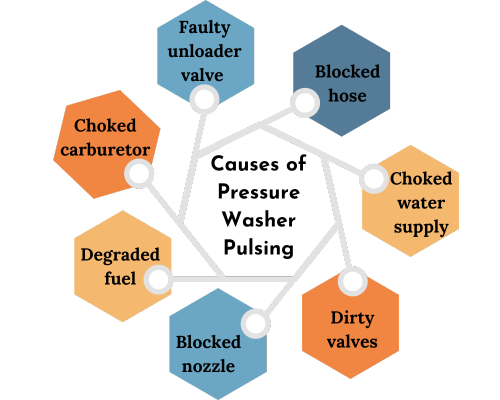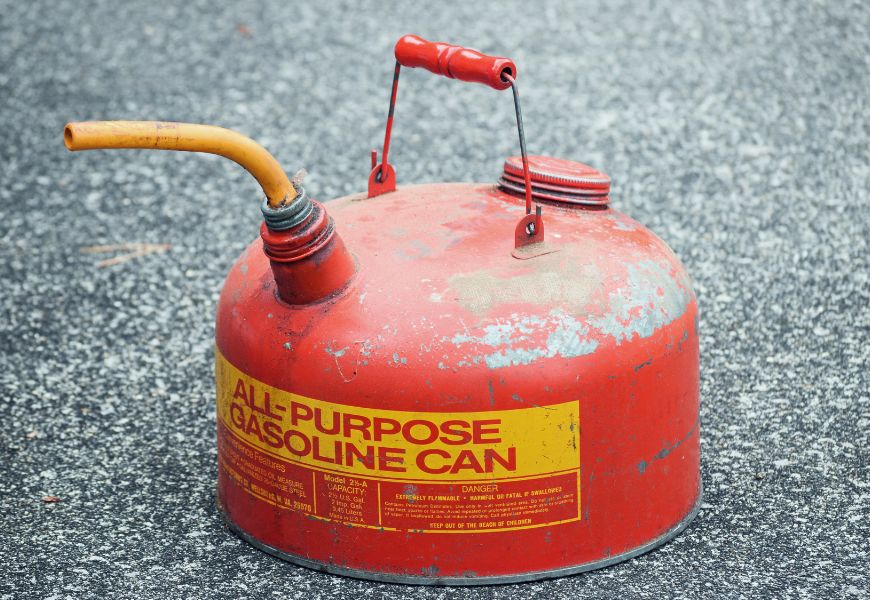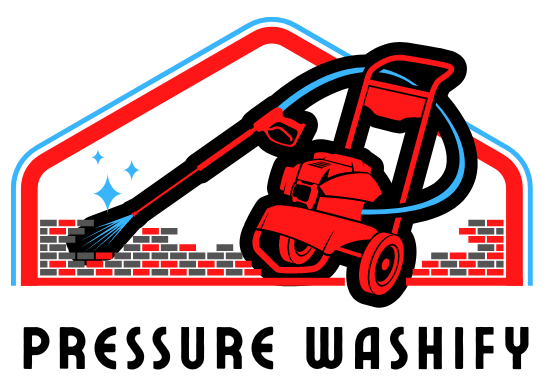Affiliate Disclaimer: This post may contain affiliate links, meaning we get a commission if you decide to make a purchase through our links, at no extra cost to you.
Pressure washers are great tools for cleaning, but they can be tricky to use. One common issue is when the water stream starts to stutter instead of flowing smoothly. This can be frustrating and slow down your cleaning progress.
It’s important to know that this is called pulsing or surging, a normal phenomenon that can happen with pressure washers.
What Does it Mean by Pulsing Pressure Washer?
A pulsing or surging pressure washer experiences fluctuations in water pressure. This manifests as irregular bursts of high and low pressure during operation. These fluctuations can stem from various issues such as air leaks, pump problems, or blockages in the system.
Common causes of a pulsing pressure washer

- Unloader valve issues: A faulty unloader valve disrupts water flow and causes pulsation.
- Water-starved pump: Insufficient water flow leads to pressure jumps, like gasping for air. Ensure steady, generous water supply.
- Head washout: Damaged pump heads can’t hold pressure properly, causing pulsation. Inspect for wear and tear and repair or replace if needed.
- Clogged nozzles: Dirt and debris can block nozzles, disrupting water flow and causing pulsation. Clean nozzles to restore smooth operation.
- Blocked or leaked hose: Blocked hoses or leaks can create irregular water flow, causing pulsation. Check and clean hoses or replace if needed. Ensure the water inlet valve is fully open.
- Dirty water valves: Dirt and debris in water valves can mess with water flow, leading to pulsation. Clean valves regularly. Using an inlet filter like the one below can help reduce this problem.
M MINGLE Pressure Washer Inlet Filter

- Connects to pressure washer inlet
- Prevents blockage
- Protects pressure washer parts
- 3/4 inch GHT male & female thread
- Hard water residues: Mineral deposits from hard water clog the device, restricting water flow and causing surging.
- Restricted carburetor: Dirt and debris can clog the carburetor, disrupting the air-fuel mix and causing surging at idle.
- Degraded fuel: Old, degraded fuel loses effectiveness, leading to poor engine performance and surging.
How to Troubleshoot?
Clearing a Blocked Nozzle
You may need a nozzle cleaning kit for this step. Here is everything you need to do:
- Disconnect the power source before you start.
- Start the process by turning off your inlet water.
- Remove the spray nozzle from your washer.
- Look inside the nozzle. Can you spot any foreign objects in there? If yes, fetch a pin or a small wire.
- Use your chosen tool to dislodge any debris you find gently. Be gentle! You don’t want to damage your nozzle.
- Once done, reconnect the nozzle to your washer.
Fixing a Restricted Carburetor
- Turn off the pressure washer and disconnect the spark plug wire for safety.
- Locate the carburetor, which is usually found near the engine.
- Remove the carburetor by following the instructions provided in your pressure washer’s manual.
- Disassemble the carburetor and clean all its components using a carburetor cleaner or a mixture of warm water and mild detergent. Use a soft brush or cloth to remove any debris or dirt.
- Reassemble the carburetor and reinstall it on the pressure washer.
- Reconnect the spark plug wire and start the pressure washer to test if the surging issue has been resolved.
Degraded Fuel
- Turn off the pressure washer and disconnect the spark plug wire for safety.
- Drain the old fuel from the pressure washer’s fuel tank.
- Clean the fuel tank using a fuel tank cleaner or a mixture of warm water and mild detergent. Rinse the tank thoroughly and allow it to dry completely.
- Refill the fuel tank with fresh gasoline, preferably with a fuel stabilizer to prevent future degradation.
- Reconnect the spark plug wire and start the pressure washer to test if the surging issue has been resolved.

Addressing Unloader Valve Problems
- Always start by turning the pressure washer off.
- Extract the unloader valve.
- Examine the valve’s spring. If it seems worn or broken, you need a new one.
- Now, look at the valve itself. Does it show signs of wear and tear? If yes, go ahead and replace it.
See if that fixes the problem. Well done! If not, you’ve done all you can. Now, it might be time to call in the pros.
Frequently Asked Questions (FAQs)
What could cause a pressure washer pump to pulsate at high rpm?
A: High RPM pulsation in a pressure washer pump is typically related to an inadequate water supply, air entrainment in the pump, or a malfunctioning unloader valve. Ensure the water supply is sufficient and check for clogged filters or hoses that might introduce air into the system. Moreover, inspect the unloader valve for proper function and adjustment.
Can a faulty nozzle contribute to a pressure washer’s pulsing issue?
A: Absolutely. A worn-out, partially clogged, or incorrect nozzle size can cause pulsing by disrupting the flow and pressure balance within the system. It’s critical to use nozzles that match the specifications of your pressure washer and to keep them clean and in good condition.
How does an imbalanced water supply affect pressure washer performance?
A: An imbalanced water supply can significantly affect performance by causing fluctuations in water pressure and flow rate, leading to pulsing. A consistent, adequate water supply according to the pressure washer’s specifications is vital for stable operation. Any deviation can cause pulsation due to the pump struggling to maintain consistent pressure.
Is it possible for electrical issues to cause pulsation in electric pressure washers?
A: Yes, electrical issues, such as insufficient power supply, voltage fluctuations, or a malfunctioning motor, can lead to pulsation in electric pressure washers. Ensuring a stable power supply and routine maintenance checks on the electrical components can mitigate this issue.
Can prolonged inactivity lead to pulsing problems in pressure washers?
A: Prolonged inactivity can contribute to pulsing problems due to the potential for seals to dry out, corrosion to develop in critical components, or sediments to accumulate within the system. Regularly running the pressure washer, even during periods of non-use, can help maintain the integrity of its components.
How does the unloader valve configuration affect pressure washer pulsing?
A: The unloader valve plays a crucial role in regulating pressure within the pressure washer. Incorrect adjustment or failure of this valve can cause pulsing by not properly redirecting water flow when the trigger is released, or by failing to maintain consistent pressure during operation. Careful adjustment according to manufacturer specifications is essential.
What role does pump type play in pressure washer pulsing issues?
A: Pump type can influence the likelihood and causes of pulsing. For example, axial cam pumps are less complex but might be prone to pulsation due to wear or imbalance more quickly than triplex pumps, which are designed for durability and consistent performance. Understanding the characteristics of your pump type can guide troubleshooting efforts.
Can adhesives or sealants used in pressure washer assembly contribute to pulsing?
A: If adhesives or sealants block water passages or are incorrectly applied during maintenance or repair, they can contribute to pulsing by restricting water flow or causing leaks within the system. It’s important to follow the manufacturer’s guidelines for maintenance and repair to avoid such issues.
How does hose length and diameter affect pulsing in pressure washers?
A: Using a hose that is significantly longer than recommended or with a diameter not suited to the pressure washer’s specifications can cause pulsing. This is due to the increased resistance and the time it takes for water to travel through the length of the hose, affecting the pressure and flow rate consistency.








